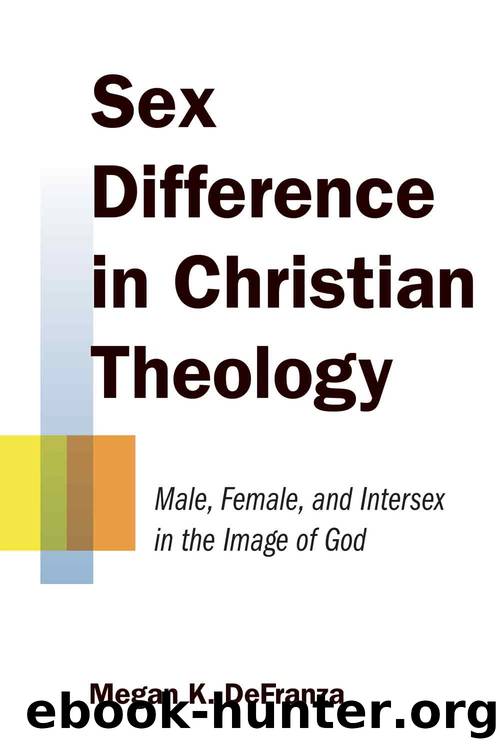Sex Difference in Christian Theology by DeFranza Megan K.;

Author:DeFranza, Megan K.;
Language: eng
Format: epub
Publisher: William B. Eerdmans Publishing Company
Published: 2015-05-08T12:24:28+00:00
The Binary Model in Stanley Grenzâs Evangelical Theology
In his earlier work, Sexual Ethics, Stanley Grenzâs theological reflection on the nature of human sexuality is similar to John Paul IIâs in that its scope is limited by his attention to heterosexual ethics, thus assuming the male/female binary model. In his later work, The Social God and the Relational Self, as well as his summary essay, âThe Social God and the Relational Self: Toward a Trinitarian Theology of the Imago Dei â (published the year of his untimely death), wherein he had the opportunity to look beyond the sexual, he does not. Rather, he expands the heterosexual model to argue that sexuality (i.e., the heterosexual drive toward marital bonding) provides the basis for all human relationality, including human relation to God (spirituality), and the bonded ecclesial community. This latter emphasis, on the place of sexuality, will be explored in the next chapter. In this chapter we must focus on his construal of male and female, rather than the nature of their bond.
For Grenz, heterosexual (marital) bonding is not the final form of the imago Dei. It is the foundational form. Grenz reads the development of the imago Dei in three canonical moves: (1) From a creation-Âcentered anthropology beginning with Adam and Eve, who are made âin [Godâs] image and according to [Godâs] likenessâ (Gen. 1:26 NRSV); (2) to a christocentric anthropology identifying Jesus Christ as the âimage of the invisible Godâ (Col. 1:15 NRSV) and âthe exact representation of [Godâs] beingâ (Heb. 1:3 NIV). But he does not stop there. (3) From here Grenz argues that the Scriptures teach us that âGodâs intention is that those who are in Christ participate in his destiny and thereby replicate his glorious image.â33 âFor those God foreknew he also predestined to be conformed to the likeness of his Son, that he might be the firstborn among many brothersâ (Rom. 8:29 NIV). Commenting on this verse, Grenz writes,
The climax of the verse comes in the subordinate clause that follows, âthat he might be the firstborn,â which expresses the Christological intent of Godâs foreordination, namely, the pre-Âeminence of Christ among those who participate in the eschatological resurrection. . . . Consequently, humankind created in the imago Dei is none other than the new humanity conformed to the imago Christi, and the telos toward which the Old Testament creation narrative points is the eschatological community of glorified saints.34
Given his larger vision of the imago Dei as the eschatological body of Christ, it might appear pedantic to focus on his construal of masculinity and femininity. Nevertheless, I believe that the way in which Grenz extends heterosexuality as the basis for all human relations, even eschatological relations of the bonded, ecclesial community, justifies a more careful look at the basis of his project.
In chapter 1 of his Sexual Ethics: An Evangelical Perspective, he argues that sexuality (i.e., sex differentiation with its [assumed] corresponding gender distinctions) is essential to the human person. Where John Paul II used the term âconstitutive,â Grenz uses âessential,â but both argue that sex, gender, and sexuality are not mere attributes.
Download
This site does not store any files on its server. We only index and link to content provided by other sites. Please contact the content providers to delete copyright contents if any and email us, we'll remove relevant links or contents immediately.
Christian Ethics for a Digital Society by Kate Ott(724)
Fearfully and Wonderfully Made by Philip Yancey & Paul Brand(704)
The World from 1450 To 1700 by Wills John E.;(655)
God and the Multiverse by Victor J. Stenger(614)
Numbers by Ronald B. Allen(578)
How to Read Slowly by James W. Sire(560)
Christian Ethics: An Introduction to Biblical Moral Reasoning by Wayne Grudem(557)
Morality by Jonathan Sacks(511)
Monastic Archaeology by Unknown(494)
The Technological System by Jacques Ellul(482)
The Disabled Church by Rebecca F. Spurrier;(470)
Jesus: A New Vision by Whitley Strieber(467)
Amish Grace by Donald B. Kraybill & Nolt Steven M. & Weaver-Zercher David L(466)
Children of Lucifer; The Origins of Modern Religious Satanism by Ruben van Luijk(458)
Death of the Doctor by Unknown(451)
Critical Writings by Joyce James;(450)
Redeeming Sociology by Vern S. Poythress(440)
The City of God by Saint Augustine & Marcus Dods(436)
The Church in the Early Middle Ages by G.R. Evans(421)
